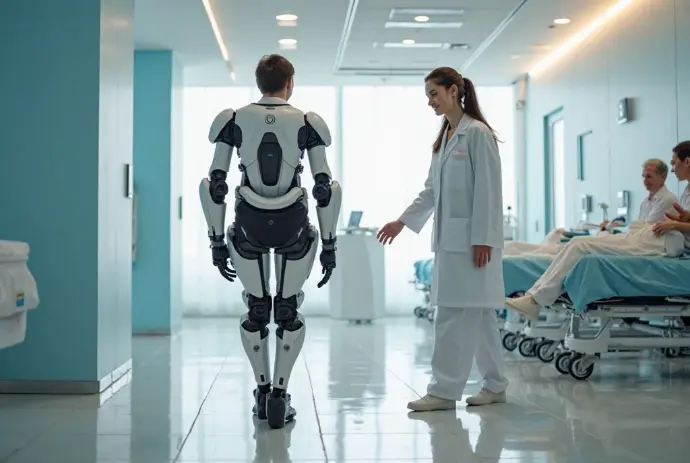In this space, you'll have the opportunity to delve into the exciting realm of new technologies and see how they are changing everyday life. From artificial intelligence to robotic assistance for people with disabilities, in our core content "Breaking Barriers: People with Disabilities and Robotic Assistance," we'll analyze how technology is creating new opportunities and challenges. Join us on this journey of discovery and technological advancement!
In an increasingly technology-driven world, innovative solutions are transforming the lives of millions of people, and among them, people with disabilities are at the center of this revolution. The integration of robots into the field of assistance is not only opening new doors, but is also challenging limits that previously seemed insurmountable.
From exoskeletons that restore mobility to those with motor difficulties, to assistant robots that provide support with everyday tasks, robotic technology is advancing by leaps and bounds. These developments not only improve quality of life but also promote greater autonomy, a key factor in fostering independence and dismantling the stigmas that often accompany disability.
Robotic assistance is no longer a dream of the future; it is a tangible reality that continues to evolve. For example, robots designed specifically to help around the home can handle everything from cleaning to more complex tasks like cooking. Devices are even emerging that assist with communication for people with hearing or visual impairments, thus increasing their possibilities for social and professional interaction. These advances have not come without challenges. Implementing accessible technologies remains critical, as it requires inclusive infrastructure, affordable costs, and broader social acceptance. However, the benefits these solutions bring far outweigh the initial obstacles, becoming essential tools for creating a more equitable environment.
The key is to continue promoting research and development with approaches focused on the needs of end users. Furthermore, it encourages collaboration between the public and private sectors to ensure that people with disabilities have access to these technologies. Because ultimately, when we break down barriers with innovation, we build a world where everyone has the opportunity to shine.
Breaking down barriers has never been easy, but robotic assistance is proving that an inclusive future is more possible than ever. It's time to look beyond the limits and celebrate how technology is transforming realities.
Introduction
Assistive robotics have dramatically changed the lives of people with disabilities, providing innovative solutions that allow them to cope with difficulties and increase their autonomy. Advances in this sector have created unparalleled opportunities to improve the mobility, communication, and independence of these individuals, positively impacting their daily lives.
Assistive robotic devices, such as exoskeletons, advanced prosthetics, and special communication systems, have proven essential in empowering people with disabilities, giving them the ability to actively participate in the community and navigate various areas of life. This technology has greatly contributed to social inclusion and has removed obstacles that long restricted opportunities for these individuals.
Additionally, assistive robotics have generated a favorable emotional and psychological effect, offering people with disabilities a greater sense of control, confidence, and well-being. The ability to perform daily tasks more independently has boosted their self-esteem and promoted greater participation in decision-making, having a significant impact on their quality of life.
The development of robotic technology focused on assisting people with disabilities has been impressive, with notable improvements in the precision, functionality, and adaptability of devices designed to make their lives easier. From early models to today's solutions, robotic technology has changed significantly, offering a wider variety of personalized and effective options.
Advances in biomechanical engineering and the incorporation of intelligent systems have made it possible to create prosthetics and exoskeletons that adapt more naturally to the body's movement, ensuring smoother mobility and superior functionality. Furthermore, reduced component size and improved energy use have contributed to assistive devices that are lighter, more durable, and more comfortable for extended use.
In the field of assistive communication, robotic technology has made it possible to develop systems that are easier to use and adaptable to each person's individual needs. These innovations have created new opportunities for interaction and expression, allowing people with disabilities to communicate more effectively and participate actively in social, educational, and work settings.
Robotic Assistance for People with Disabilities
Robotics is no longer a concept exclusive to science fiction and is now an essential part of our daily lives, transforming multiple sectors. One area where its impact is especially significant is in assisting people with disabilities. Thanks to technological advances, innovative solutions are being developed that drastically improve quality of life, providing greater autonomy, accessibility, and support.
People with disabilities face everyday challenges that often go unnoticed by others. Whether it's reduced mobility, communication difficulties, or sensory limitations, robotics is offering tools that open up new possibilities. Exoskeletons that restore mobility to those unable to walk, robotic arms that offer functional extension for daily tasks, and even virtual assistants specially designed to understand and respond to specific needs are just a few examples of the positive impact being achieved.
Robotic exoskeletons are a major advancement in this area. These structures, created to adapt to the human body, allow people with paralysis or muscle weakness to walk again or perform movements that seemed impossible. Although they are still expensive, their potential to improve the lives of millions is incalculable.
On the other hand, robotics is also present in communication devices used by people with speech or language disabilities. Assistants such as those developed with artificial intelligence are capable of processing complex patterns, transforming minimal physical signals into words or complete phrases, facilitating more natural and effective interaction with the environment.
Likewise, the design of robotic technologies focused on accessibility continues to be a field of constant innovation. Autonomous devices such as smart wheelchairs, capable of navigating complex environments thanks to advanced sensors, or assistant robots that help around the home provide not only functionality but also independence to their users.
The integration of robotics and accessibility represents a paradigm shift in the way we address disabilities. Although challenges still exist, such as the need to reduce costs and make these technologies more accessible to all sectors, the potential of these solutions is undeniable.
We are living in an era in which technology not only complements our daily lives but also transforms individual realities. Assistive robotics not only empowers people with disabilities but also demonstrates what we can achieve when we combine science and empathy. With each new development, a door opens to a more inclusive future, where barriers begin to blur. And that, without a doubt, is something worth celebrating and supporting.
Robotic assistance for people with disabilities brings several important benefits that improve users' quality of life. Robotic devices can offer physical support in daily tasks, allowing people with disabilities to perform activities that would otherwise be difficult or impossible. Furthermore, robotic assistance can increase autonomy and boost confidence by allowing individuals to perform tasks without always relying on caregivers or family members.
Likewise, robotic technology can promote social inclusion by enabling people with disabilities to integrate more actively into society. Robotic assistance devices, such as exoskeletons or mechanical arms, can help people move more easily, allowing them to participate in recreational and work activities more independently.
Finally, the use of robotic assistance for people with disabilities can positively influence their emotional health by reducing feelings of dependency and increasing control over their lives.
Assistive robotics have a wide variety of uses in the daily lives of people with disabilities. Robotic devices can be used to improve mobility, facilitate object manipulation, assist with communication, and even enable access to education and employment. For example, robotic exoskeletons can help people with disabilities walk, while robotic arms can allow them to handle objects at home or at work.
Furthermore, assistive robotics can be used to increase accessibility in public spaces, enabling people with disabilities to move more independently and participate in various activities. Assistive robotic devices also help improve inclusion in education and employment by providing tools that facilitate participation in these fields.
Assistive robotics has the potential to change the daily lives of people with disabilities by equipping them with the tools necessary to overcome obstacles and actively participate in society.
Technological developments in the field of robotic assistance for people with disabilities have been remarkable in recent years. The reduction in component size, advances in artificial intelligence, and the invention of lighter and more durable materials have allowed for the development of more efficient and multifunctional robotic devices.
Specifically, artificial exoskeletons have shown remarkable progress, with more comfortable shapes and more precise handling systems. These developments have facilitated the mobility and independence of people with disabilities, giving them the opportunity to do things they couldn't before.
Furthermore, the combination of interfaces that connect the brain and the computer has created new opportunities in robotic assistance, allowing people to operate devices through brain signals. This innovative technology has the potential to offer greater autonomy to people with disabilities, allowing them to interact with robots more easily and directly.
Human-Robot Interaction in the Context of Assistance for People with Disabilities
The relationship between humans and robots is key to the advancement of assistive tools for people with disabilities. With advances in robotics and autonomous systems, devices have been created that can improve the lives of people with disabilities. This interaction between humans and robots allows these technologies to adapt to each person's particular needs, offering a level of personalization that had not been achieved before.
Robotic assistance for people with disabilities includes diverse applications, such as exoskeletons that help restore mobility, as well as home assistance devices that simplify daily tasks. The relationship between humans and robots is vital to ensuring that these devices are simple and intuitive, facilitating better integration of people with disabilities into their environment.
The human-robot relationship is fundamental to creating and implementing assistive technologies that truly improve the lives of people with disabilities.
The introduction of robotic assistance for people with disabilities brings with it several ethical and social challenges that must be carefully addressed. One of the main ethical challenges is ensuring that these new technologies respect the autonomy and worth of people with disabilities, rather than restricting their independence or making them objects of care.
Furthermore, the addition of robots to healthcare and social care also raises concerns about privacy and the protection of user information. It is essential to define clear guidelines for the collection, storage, and use of data, thereby protecting the privacy of people with disabilities and ensuring that their rights are always respected.
From a social perspective, the integration of robotic assistance for people with disabilities also faces challenges related to acceptance and adaptation by society as a whole. It is essential to promote a positive view of these technologies, encouraging inclusion and providing equal opportunities for people with disabilities in all aspects of life.
The future of the relationship between humans and robots in the context of disability assistance is promising, with remarkable potential to improve the lives of millions around the world. As technology continues to develop, we are likely to witness even more extraordinary advances in the creation of robotic assistance devices and systems.
The relationship between humans and robots is expected to become more intuitive and natural, allowing people with disabilities to operate and communicate with assistive devices more easily and effectively. Furthermore, the customization and adaptability of these technologies are likely to improve, offering solutions that are optimally suited to the unique needs of each user.
Human-robot interaction will continue to be central to the development of assistive technologies for people with disabilities, opening up new opportunities for inclusion, autonomy, and well-being for those who benefit from these innovations.
Future Applications of Robotic Assistance for People with Disabilities
Currently, the field of robotic assistance for people with disabilities continues to advance, with technological innovations that have the potential to improve the quality of life of those who require special support. From mind-controlled exoskeletons to bionic prosthetics equipped with motion sensors, these emerging technologies are creating new opportunities for mobility and autonomy for people with disabilities.
Advances in 3D printing have also made it possible to manufacture affordable, personalized devices, making it easier for more people to access robotic assistance. These innovations are not only changing the daily lives of people with disabilities, but are also paving the way for a future where inclusion and equal opportunities become a reality for all.
With the constant advancements in robotics and engineering, even more exciting developments in the field of robotic assistance are anticipated in the coming years, providing new solutions and significant improvements in the daily lives of people with disabilities.
Artificial intelligence (AI) is playing a key role in the creation of assistive solutions for people with disabilities. AI systems allow for the development of adaptive technologies that can learn and adjust to each user's particular needs, resulting in more personalized and effective robotic assistance.
Furthermore, AI is being used to enhance the capabilities of assistive devices by interpreting and reacting to brain signals, facilitating more advanced and precise brain-machine interfaces. This means that people with disabilities will be able to operate robotic devices more easily and accurately, giving them greater independence and control in their daily activities. With the continued advancement of AI, it is anticipated that its influence on the creation of assistive solutions for people with disabilities will continue to grow, leading to increasingly sophisticated and effective innovations in the field of robotic assistance.
Robotic assistance plays a fundamental role in promoting inclusion and access for people with disabilities. These technologies not only provide physical assistance but also have a significant impact on the self-esteem, autonomy, and social participation of people with disabilities.
By offering creative solutions that address physical and mental limitations, robotic assistance is making it easier for people with disabilities to integrate more deeply into their daily activities, education, work, and leisure time. Furthermore, these technologies are transforming how disability is viewed socially, showcasing the abilities and potential of people with disabilities.
Robotic assistance is not only improving the quality of life for people with disabilities, but is also helping to build a more inclusive and accessible environment for all, fostering equal opportunities and respect for diversity.
Conclusions
The incorporation of robotic assistance into the lives of people with disabilities has been a process that has evolved over time. Thanks to notable technological developments and an increased focus on accessibility, opportunities have been created for the broader inclusion of robotic assistance in the daily routines of people with disabilities.
Advances in robotics have led to the creation of tools and systems specifically designed to meet the demands of people with disabilities. From exoskeletons that facilitate movement to systems that assist with communication, robotic assistance is generating new opportunities to improve the lives of people with disabilities.
Furthermore, the fusion of artificial intelligence and machine learning has allowed robotic assistance systems to more effectively adjust to the specific needs of each person. This has resulted in greater personalization and effectiveness in the delivery of assistance, which has contributed to increasing the independence and autonomy of people with disabilities.

 IHRO NEWS
IHRO NEWS


